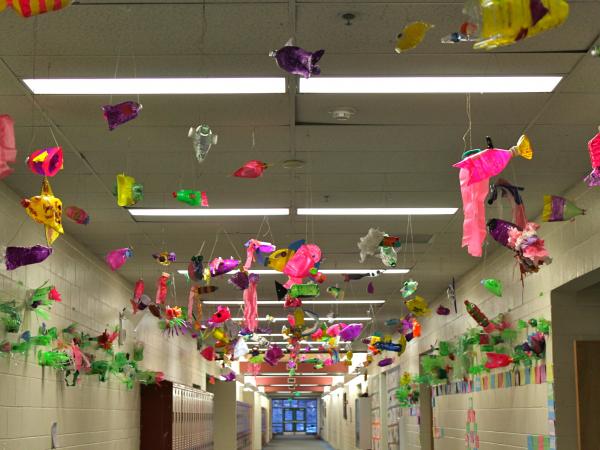Students work together to create an art installation of a watershed.
Recycled plastic serves multiple purposes in this project: it is reusable, economical material; it reflects the plastic waste that is in our water; and it shows students how much plastic we consume. Students create part of a waterfall, a fish, and a plant while learning about the different components of a watershed, including human impact on a watershed.
Objectives:
- Students will create elements of a watershed using recycled plastics
- Students will identify elements of human impact on a watershed
- Students will create an art installation representing a watershed
Basic Lesson Outline:
- Introduce the project—slide show
- Students create a waterfall, plants, and fish
- The watershed is assembled in the installation location
Art Supplies:
- Watercolor paints
- Acrylic paints
- Modge podge
- Paint brushes
- Water cups for brushes
- Scissors
- Plastic bottles
- Caps
- Tissue paper
- Glitter paint
- Colored masking tape
- Stapler
- Glue guns
- Hot glue
- Plastic film / plastic bags
- Hemp line / fishing line
- Thumb tacks
- Dowel or rod to hang the bottles
- Wire
- Wire cutters
- Eye screws
- Rope
- Colored pencils
- Drawing paper
Other Resources:
- Visual examples of fish and plants created from plastic
- Slide show to introduce project and related artwork (see outline at the end of the lesson plan)
Idaho State Learning Standards
Arts and Humanities: Anchor Standard 4: Convey meaning through the presentation/performance/production of an original work or unique interpretation of a work
- Objective PR1.1 Combine knowledge and understanding from two or more disciplines to present/perform their original or interpreted works for an audience
- Objective PR1.2 Convey meaning through their presentation/performance
LS2-MS Ecosystems: Interactions, Energy, and Dynamics
- LS2-MS-1. Analyze and interpret data to provide evidence for the effects of resource availability on organisms and populations of organisms in an ecosystem.
Further Explanation: Emphasis is on cause and effect relationships between resources and growth of individual organisms and the numbers of organisms in ecosystems during periods of abundant and scarce resources
- LS2-MS-3. Develop a model to describe the cycling of matter and flow of energy among living and nonliving parts of an ecosystem.
Further Explanation: Emphasis is on describing the conservation of matter and flow of energy into and out of various ecosystems, and on defining the boundaries of the system
- LS2-MS-6. Evaluate competing design solutions for maintaining biodiversity and ecosystem services
Further Explanation: Examples of ecosystem services could include water purification, nutrient recycling, and prevention of soil erosion. Examples of design solution constraints could include scientific, economic, and social considerations.
Academic Language:
- Subject area language: watershed
- Art language: art installation
Student Use of Vocabulary:
Students will use the words when creating their projects
Student Grouping:
Students will work individually or in small groups


0 comments
Leave a Comment